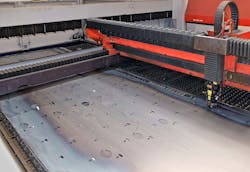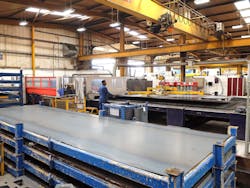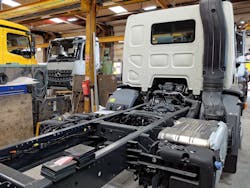Laser cutting helps manufacturer to gain strength
CHRIS WRIGHT
If you find yourself in the UK driving behind a gritter or salt spreader this winter (in other countries, these may be known simply as sanders), there is an 80% chance it was bought or hired from winter maintenance equipment manufacturer Econ Engineering (Ripon, England) by the local council or highways contractor. The company is the largest UK manufacturer of such vehicles (FIGURE 1), producing 360 units per year at its 88,000-sq-ft. factory, which opened in 1980. Additionally, it operates a growing hire fleet of currently more than 800 units, which has boosted annual turnover to over £34 million (about $37.3 million), making the firm a major contributor to the local economy.
In its 50th year, Econ is experiencing an unprecedented order book partly fueled by recent harsher winters, but also due to the multibody products that allow customers to utilize one chassis for multiple tasks. These tasks include road repair as well as winter maintenance, making the investment usable throughout the year.
The 220-employee company’s dominance in the market is due to the premium quality of its products, with all design and manufacturing carried out in-house. Sheet metal processing machinery from Bystronic (Niederönz, Switzerland) has helped Econ, for nearly one-third of its 50-year existence, to maintain the high level of component accuracy that underpins its reputation for top quality.
The late Bill Lupton singlehandedly started a business in the 1950s in a barn on his family’s farm making flail mowers and hedge trimmers to cut verges and hedgerows more efficiently. Exceptionally cold and freezing weather during the winter of 1962-1963 brought England to a standstill, with many being cut off for weeks. It inspired Lupton to put his mind to developing the first salt-spreading vehicle that would keep the country moving and the wheels of industry turning.
To manufacture them in 1969, he started Econ Engineering in an old brewery site in Ripon. By then, the M1 motorway had opened as well as sections of the M2, M4, and M6—and local councils, notably Lancashire and Westmorland, were expressing considerable interest in winter maintenance operations such as salt spreading and gritting to make driving safer.
In 2003, the second generation of Luptons—Jonathan and Andrew—took over running the company and they were instrumental in developing contract hire for gritters and snow plows at a time when public spending cuts were making new equipment purchases difficult. In 2005, underlining their commitment to building up this side of the business, they increased the fleet size through the acquisition of a major competitor.
It was in the early 2000s that the first Bystronic laser machine replaced a turret punch press and a plasma profile cutter for processing the majority of components made from mild steel plates (FIGURE 2). In addition to being used in the manufacture of gritting and salt-spreading equipment, the components also find their way into snow plows as well as bodies for highway maintenance and road patching that Econ mounts onto truck chassis supplied to clients’ specification.Bystronic’s BySoft off-line programming software automatically nests the components for maximum sheet utilization. It then produces the cutting plans—in this case, up to 14 days in advance of scheduled production to assist ordering of material—and monitors the manufacturing processes in real time. The effectiveness of these procedures is evidenced by an above-average overall equipment effectiveness of 63%, representing the proportion of time the laser is actually cutting metal.
More than 70% of the output from the laser machine is folded on three Bystronic press brakes on site. Two of these machines, positioned side by side, are used either independently or in tandem for bending very large components. In use also is an Xpert 40 ton/1 m press brake for bending smaller parts more efficiently and therefore cost-effectively. It can easily be relocated within the factory to where it is most needed.
“We have always tried to innovate and strive for excellence and nowhere is that more apparent than in our use of the laser to cut steel in our body shop,” says Jonathan Lupton, joint managing director. “Despite the machine representing a considerable expense at the outset, it was another example of how we always lead the way in our industry. The investment has more than paid off in terms of higher production output, while improved accuracy has almost eliminated fit-up during assembly and cuts costs further.”
He continues, “We have gone from strength to strength by focusing not only on quality, but also on the needs of our customers. That is why we have a UK-wide network of depots for servicing and recalibrating our equipment in the field, including a new one that opened recently and another due to open in Cardiff in spring 2020.”
In 1989, Econ was the first to invent the quick-change body system that allows a single chassis to have multiple applications—for example, by the addition of an asphalt hot box for road repairs or for use as a tipper, crane, or gulley emptier. It reduces capital investment by a council, which no longer needs multiple vehicles to satisfy the same range of year-round tasks.
A recent Econ invention was a system that controls grit or salt spray and width patterns from the cab, automatically optimizing the amount of product used, saving cost as well as protecting the road surface. It also provides one-touch control for lowering the snow plow, turning on the gritter’s beacon bar and performing other functions, making the driver’s tasks easier and less tiring. For greater efficiency, it is connected to the vehicle’s GPS to help plot the most effective route. New technology in the company’s sights include driverless vehicles and liquid de-icers, intended to be less harmful to a road surface.
CHRIS WRIGHT ([email protected]) is a marketing services consultant for Bystronic UK, Coventry, England; www.bystronic.co.uk.



